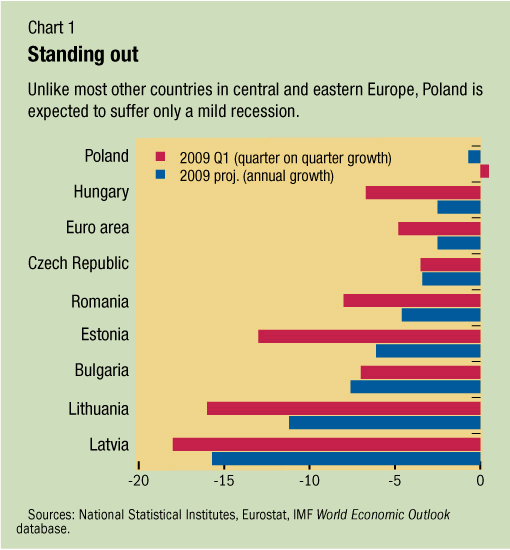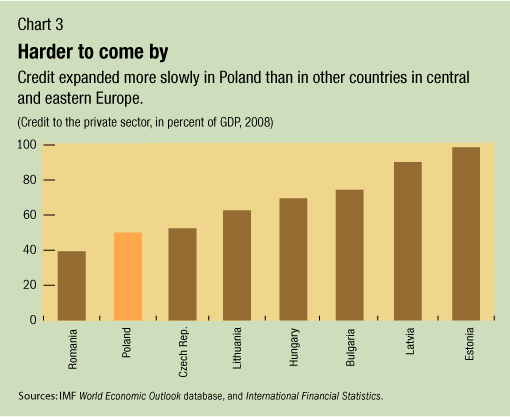ECONOMIC HEALTH CHECK

Typical street scene in Santa Ana, El Salvador. (Photo: iStock)
IMF Survey: Poland: Bright Spot in Recession-Hit Europe
August 13, 2009
- Mild recession expected
- Policymakers have some room to counter business cycle
- Recovery depends on global conditions
Compared with most other countries in central and eastern Europe, Poland is expected to experience a mild recession.

Factory in Rzeszow, Poland, where domestic economy is large, relatively closed compared to other similar countries (photo: Bartosz Bator/EPA/Corbis)
The IMF is projecting a small contraction of about ¾ percent for 2009, based on a weak outlook for global trade and further expected declines in domestic investment, credit, and wage growth. In its regular review of the Polish economy, the IMF expects a modest recovery of about 1½ percent in 2010, although that is predicated on a recovery in the global economy.
The global economic crisis has hit Europe with full force. With trade and financial markets collapsing late last year, and consumer and business sentiment plunging, most economies contracted in the last quarter of 2008 and first quarter of 2009. This year, growth is expected to decline by close to 5 percent in the euro area, and countries such as Bulgaria, Romania, and the Baltics are likely to experience particularly sharp recessions.
While Poland has not emerged unscathed from the crisis, it has fared much better than its neighbors (see Chart 1). Following the demise of U.S. investment bank Lehman Brothers, the Polish interbank market froze, as happened elsewhere. Credit default swap (CDS) spreads rose, and the zloty quickly lost close to a third of its value.

But Poland’s growth remained slightly positive in the last quarter of 2008 and first quarter of 2009, helped by resilient consumption growth and the economy’s limited exposure to the decline in world trade—Poland’s domestic economy is large and relatively closed compared to other similar countries, with exports playing a much smaller role.
Reaping the benefits of sound policies
Why is Poland different? To be sure, its flexible exchange rate regime has served it well by facilitating the economy’s adjustment to the external shock. Also, the approval of an IMF credit line for Poland earlier this year—a new instrument known as the Flexible Credit Line—helped calm markets. The zloty stabilized at its new lower level, CDS spreads declined, and the government—which, throughout the crisis, had maintained access to international markets—saw a decline in the interest rate it was paying on its bonds.
But, most importantly, Poland’s resilience owes much to sound economic policies that have helped the country avoid the buildup of large external and internal imbalances seen elsewhere in central and eastern Europe (see Chart 2). Because Poland entered the crisis with relatively healthy fundamentals, the government has been able to implement countercyclical policies. These, in turn, are now cushioning the downturn.

Countercyclical monetary policy
The National Bank of Poland has built strong anti-inflation credentials during the past decade, and this helped anchor inflation expectations. Its credibility with markets and the public allowed the central bank to gradually reduce interest rates soon after the global crisis hit. Since November 2008, it has lowered its policy rate from 6 to 3.5 percent.
Looking ahead, the IMF expects inflation to continue to decline, providing room for additional cuts in the policy rate. Such cuts are not expected to weaken the zloty further, given that Poland’s monetary policy stance and cyclical position have been strengthening relative to the euro area and the United States. Nevertheless, the risk of negative spillovers from the region remains, and this could put temporary pressure on the zloty. So caution is called for when loosening monetary policy.
Fiscal policy at a crossroads
The authorities’ plans to adopt the euro and the country’s commitments under the Maastricht Treaty have helped anchor expectations about fiscal policy and facilitated the reduction in 2007 of the fiscal deficit to below the Maastricht limit of 3 percent of GDP. But with revenues expected to fall because of the downturn and important tax reforms coming into force in 2008 and 2009, the deficit is rising again.
At present, the challenge for fiscal policy is to balance short-term cyclical concerns with medium-term commitments. Permanent tax cuts enacted earlier but coming into effect now have already provided an important stimulus during the slowdown. But they will also have the effect of keeping the deficit above the Maastricht limit even as the economy recovers, jeopardizing the authorities’ medium-term plan to reduce it to 1 percent of GDP by 2012. Yet taking drastic corrective action to reduce the deficit now would risk turning a mild recession into a more serious one.
The authorities have struck the right balance between these considerations by deciding to increase the deficit limit for 2009 to mostly accommodate the expected shortfall in revenues. To fulfill their medium-term targets, albeit with some delay, the authorities would need to start a sustained fiscal consolidation in 2010, provided the recovery takes hold as projected. Moreover, to help anchor confidence in their targets, the IMF recommends revamping the fiscal framework to include multi-year binding limits on expenditures.
Poland’s early implementation of comprehensive pension reforms means that the issue of aging does not weigh heavily on the medium-term outlook, as it does in many other European countries. This is another example of how good economic policies in the past are now affording policymakers room for maneuver.
Safeguarding financial stability
Poland’s banking system has withstood the global turbulence well. In part, this is due to the economy’s lower leverage—the credit expansion in Poland was less dramatic than elsewhere, having started later and from a lower base (see Chart 3). Even though the system is dominated by foreign-owned banks that are still facing challenges in global markets, parent banks have maintained their exposure and have continued to provide funding and capital to their Polish subsidiaries.

The authorities have been vigilant and proactive. They have, for instance, encouraged banks to retain profits and have stepped up top-down stress testing and on-site inspections. The IMF is advising the government to go one step further and conduct bank-by-bank stress tests, which could be coordinated with neighboring countries to take into account the regional dimension of the problem. This would help alleviate uncertainty and would facilitate the functioning of the interbank market.
But, ultimately, revival of credit, which is key for the recovery, will depend on external conditions. So far, foreign-owned subsidiaries have been reluctant to lend to each other domestically, mirroring the reluctance of their parents to do so. This implies that normalizing financial markets in Poland will, to a large degree, depend on normalizing such markets globally.
For now, Poland has managed to hold up amid crisis-stricken neighbors. The chances that it will pull through this difficult period are good. But to achieve a successful and sustained recovery, it ultimately needs its neighbors and trading partners to emerge from recession as well.
Comments on this article should be sent to imfsurvey@imf.org







